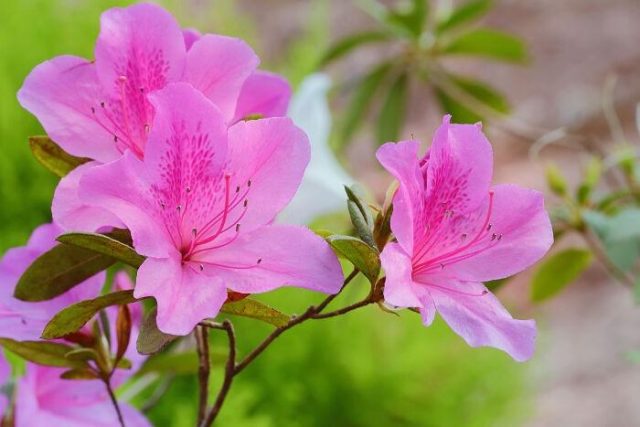Content
Azalea and rhododendron are unique plants, well known to every person who is fond of floriculture. But any person inexperienced in flowers will not be able to calmly walk past these plants in bloom, so much they fascinate with their beauty. The difference between azalea and rhododendron has caused heated debate for many years, both among scientists and among ordinary gardeners. But although in the official scientific world they came to some agreement, according to tradition, these plants continue to be called as it was customary about 100 years ago.
What is the Difference Between Azalea and Rhododendron
Both of these plants belong to the large heather family, which previously had two different places for them: the genus rhododendron and the genus azalea. The seemingly complex name of the main genus consists of two Greek words: rose (rhodon) and tree (dendron). And in translation it means - rosewood.
Only in 1583 this name was first assigned only to one specific species - p. rusty found in the Alps. Later, Karl Linnaeus, creating his famous classification of plants, indicated 9 species of rhododendrons. Among them were 3 evergreen and 6 deciduous. And he decided to classify deciduous species as a separate genus - azalea. However, azaleas have also been known since ancient times, with the only difference that their historical homeland is India, Japan and China. They do not grow in the wild in Europe.
Later, botanical scientists found out that Karl Linnaeus was mistaken, and the plants divided by him according to different genera have much more similarities than differences. Therefore, in the modern taxonomy of plants, the genus Azalea was completely abolished, and all their modern species were attributed to the genus Rhododendrons. At the moment, this genus already includes about 1300 species and more than 30,000 plant varieties. Among them there are:
- deciduous;
- semi-evergreen;
- evergreen trees, shrubs and shrubs.
However, the tradition in floriculture is very persistent, and flowers that have been called azaleas for many years have retained the right to be called that way. They were simply attributed to the genus of rhododendrons.
To date, the following species and their numerous varieties are called azaleas:
- R. western (occidentale);
- R. sticky (R. viscosum);
- R.s imsii;
- a hybrid group of varieties called Nap Hill;
- evergreen hybrids of R. blunt (Japanese azaleas).
The first two species and their varieties are deciduous, and the rest are evergreen.
And among gardeners, therefore, various delusions still take place. For example, it is believed that azaleas are deciduous rhododendrons, and there can be no evergreen species among them.
In fact, the difference between these plants is rather arbitrary and consists of several things.
It is generally accepted that rhododendrons are exclusively garden plants that can withstand significant frosts down to -20-30 ° C. While azaleas are thermophilic sissies and can grow primarily in rooms and greenhouses. This is not surprising, given their southern origin, especially the Indian azaleas.
In addition, these plants tend to vary greatly in size.Most of the varieties belong to the arboreal type and are significant in size, up to 2-3 m in height. Even shrub varieties look quite voluminous both in width and reaching one meter in height. While most azaleas belong to the shrub type and are very small in size from 30 to 60 cm in height.
Otherwise, from a biological point of view, the difference between these species is quite small: they have the same structure of the root system, as well as stems and leaves, and similar requirements for habitat conditions.
How to tell an azalea from a rhododendron
The most important difference between azaleas and rhododendrons from a botanical point of view is the number of stamens in their flowers. In azaleas, the number of stamens usually coincides with the number of petals and cannot be more than five. Rhododendrons most often have two stamens per petal, and, thus, in most species there are 10 or even more. True, there are exceptions to this rule - two species have only seven stamens per flower. But in any case, it is more than azaleas.
Otherwise, it is almost impossible for a non-specialist botanist to distinguish an azalea from a rhododendron.
What is the Difference Between Ledum and Rhododendron
There are also other plants that sometimes cause confusion in the minds of uninformed people. For example, for some reason it so happened historically that one of the varieties of the wild-growing rhododendron called Daurian, which is ubiquitous in the vastness of Eastern Siberia and the Far East, is called wild rosemary.
Of course, wild rosemary also belongs to the same heather family and is an evergreen, but no other similarities have been noted.
Moreover, the difference between these two plants is so significant that it is quite easy to distinguish them from each other even for a layman.
- Ledum prefers to grow on wet, swampy soils, it is not for nothing that the people often call it marsh stupor, and translated from Old Russian, its name means “growing on a marsh swamp”. Dahurian rhododendron is a completely drought-resistant plant.
- Ledum, at least because of its name, has a strong, yet intoxicating odor that can cause headaches. Daurian rhododendron has a pleasant aroma, slightly reminiscent of strawberries.
- Finally, the flowers of the true wild rosemary are always white, and the Daurian rhododendron has a lilac-pink color of flowers.
Nevertheless, despite the big difference in appearance, among the people, the Daurian rhododendron is so often called the wild rosemary that this fact was even reflected in the Ozhegov's explanatory dictionary.
Conclusion
The difference between azalea and rhododendron is actually so insignificant that these flowers in the modern world are quite rightly attributed to the same botanical genus. Nevertheless, the traditional approach is also convenient, since it allows them to be classified into different areas of use and cultivation: rhododendrons - to garden forms, and azaleas - to greenhouse-indoor ones.












